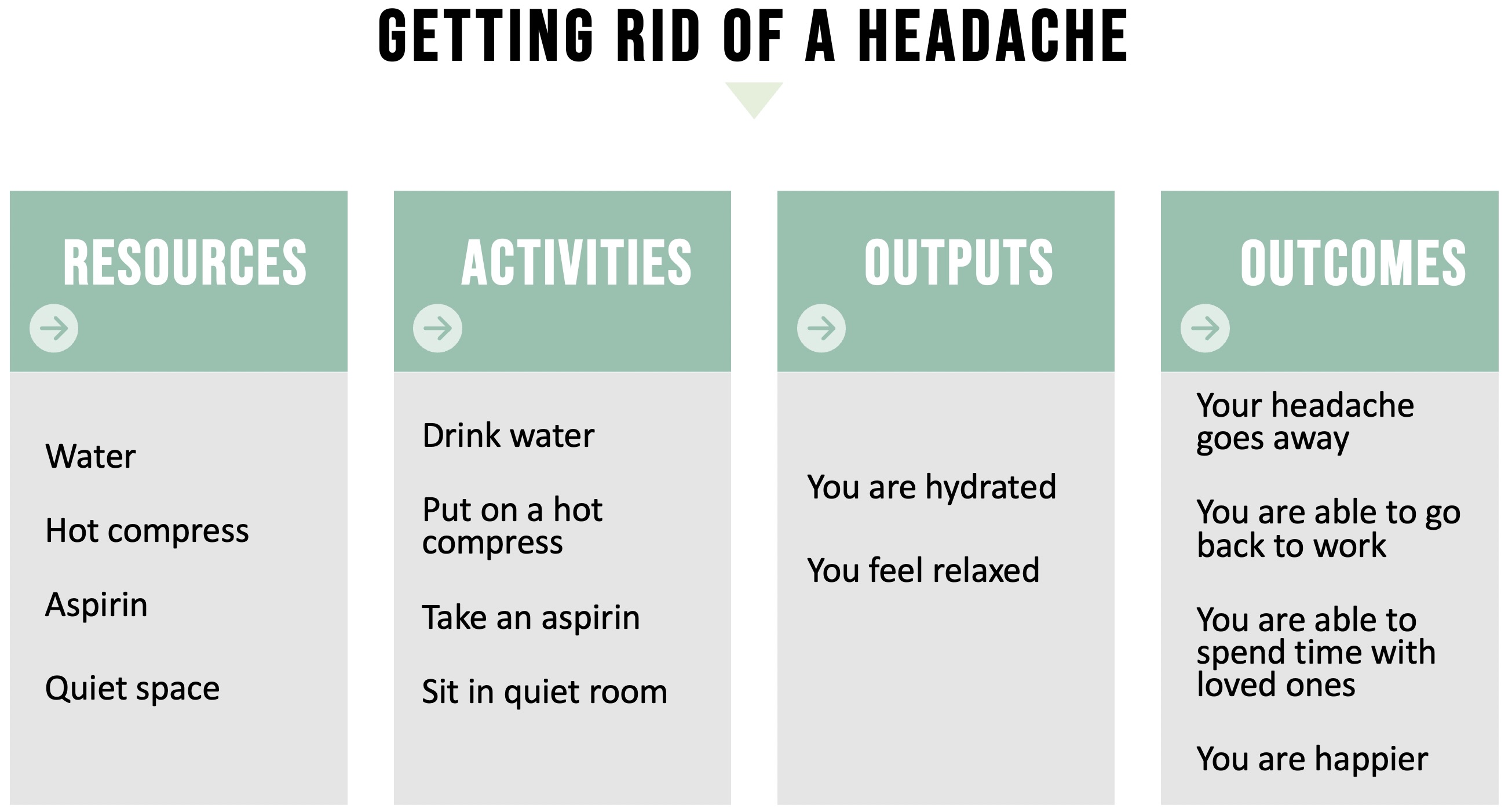Logic Model Basics

The program logic model is defined as a picture of how your organization does its work – the theory and assumptions underlying the program. A program logic model links outcomes (both short- and long-term) with program activities/processes and the theoretical assumptions/principles of the program.
– W.K.Kellogg Foundation Logic Model Development Guide
The use of Logic Models (LM) have become prevalent in all sectors, especially in education. In fact, most federal grants require an LM as part of the application. LMs make “logical” sense but creating one isn’t always logical because of confusion over terminology. For example, the difference between outputs and outcomes.
First, let’s review an LM in its simplest form. Let’s say you have a headache. A logical approach to get rid of your headache is illustrated by this LM.

Source: http://www.sedl.org/
To build an LM, start with the outcomes first (far-right column), then proceed with the inputs and strategies necessary to get results. Let’s look at a more comprehensive LM for a college readiness program.

For better viewing: http://files.eric.ed.gov/fulltext/ED556231.pdf (p. 114)
Depending on the organization, LM terminology is not always consistent.
- Outputs and outcomes can be confusing. According to Deborah Mills-Scofield, outcomes are the difference made by the outputs. For example, your headache goes away (outcome) because you’re hydrated (output). For the college readiness LM, there will be increased parental engagement in participating high schools’ student education (long-term outcome) because the program developed and delivered six workshops for parents (output).
- Notice that the college readiness program LM has the term “impacts” (far-right column). Don’t let this confuse you. Some organizations prefer to state “impacts” while others fold in this information into “long term outcomes.”
- The college readiness LM states “Resources” (first column). This term is interchangeable with “Inputs.”
- Not all LMs have a “Problem Statement” (top) and “Assumptions” (bottom). Nonetheless, I recommend including these parts in the LM. It reminds the organization what issue a program or the organization as a whole is addressing and under what assumptions.
A one-page LM graphic is a powerful visual. It is, indeed, a logical way for an organization to understand the roadmap ahead but building an LM is not necessarily logical.
Let's work on an example. To build a logic model, start with the outcomes first (far-right column), then proceed with the outputs, strategies/activities, and resources necessary to get results.
Outcomes: The institution's desired results.
Outputs: What the institution produces.
Activities: What the institution does.
Resources: What the institution has.
Outcomes
Start with the end in mind.
Example:
To close equity gaps in STEM courses by 20% by [date]. Short-term and mid-term outcomes may be added, if needed.
Outputs
Example:
Complete a 10 two-hour professional development series on equitable teaching and grading practices for 300 faculty.
Activities
Example:
Outline the professional development training, send save the dates, compile registrations, dry run the trainings.
Resources
Example:
Instructional designer, distance education coordinator, expert faculty, software, materials.
Purpose Statement
I've worked with college teams where they felt better prepared to articulate a purpose statement after working on the LM for a bit. Other teams focused on creating a purpose statement first. Either way is fine. Choose the path that best suits your context.
Example:
By establishing a STEM Center, we will provide a hub for students to receive academic & student services support, which aligned with the strategic plan to improve student transfer, especially among Black students who experience a 22% retention and 40% graduation equity gap.
Assumptions
Assumptions are reality checks. Unpack issues of capacity, logistics, buy-in, etc., and write down how to address them.
Example:
Space availability for the Center, faculty willingness to participate in PD, etc.
External Factors
Factors that might influence the institution's ability to do the work planned or potential barriers to achieving the outcomes.
Example:
University changes in STEM course transfer agreements, state-mandated pre-requisites, etc.
Finally, it's critical that the LM activities/strategies be put in a separate document with the names of those responsible for implementing them and with timelines. This document, which could be a simple spreadsheet, allows those responsible to provide a status on each of the activities.
***
Also visit: Integrated Planning Tools & Resources (access downloadable logic model templates) | Using Logic Models to Organize the Guided Pathways Work







